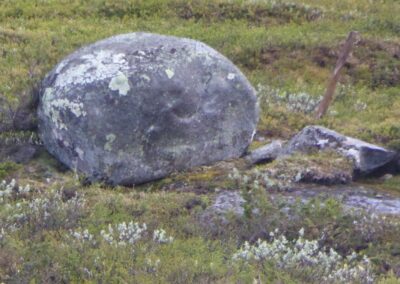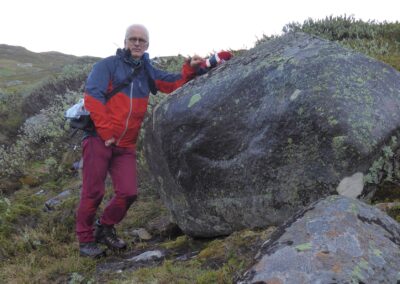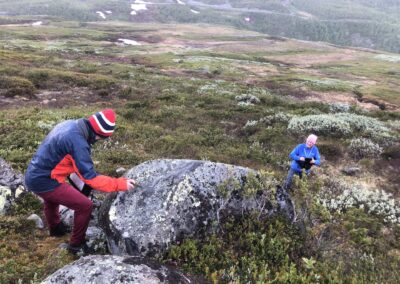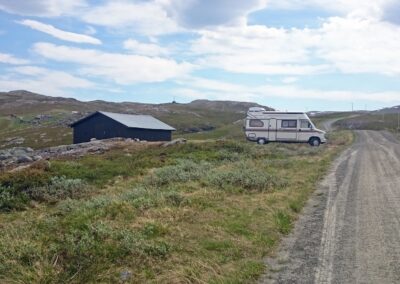The Singing Stone by Mugnestølen
Type: Ringing stone
Local name: Syngjarsteinen
Locality
County: Innlandet
Municipality: Vang
Location: Along Slettefjellvegen, by Mugnestølen
If you come from Beito, follow Lykjavegen west to a barrier where Slettefjellvegen starts. After three kilometers·by Lake Fleinsendin—the road turns sharply to the left at an intersection. From there, you find the stone below the road after about 850 meters. There is a small meeting place 60 meters northwest of a shed at the same side of the road (see photo with motorhome). From there you can see the marked stone some 25 meters down the slope.
Description
The stone is located on the alpine mountain, at 993 meter above sea level. There are many rocks in the area, but only this one is singing. The Singing Stone is oblong and rounded, and measures approximately 2 x 1.20 meters. The height is 1–1.20 meters. The stone is placed directly on the bedrock, and one of its sides is covered with vegetation. It has no visible cup marks or other wear marks. The stone produces tones with two to three different pitches. The clearest tones appear to be at the top at the part pointing westwards, and, also on the side to the east. In both spots there are two clear tones depending on where you strike. A high frequency (approx. G#) is clear both spots, while a darker frequency (around E and Eb, respectively) is audible, but not so clear.
Cultural history and tradition
The Singing Stone is not widely known in Valdres, nor in Vang, where the farms have their mountain summer pastures in this area. It seems that the stone was known only among those who had summer pastures at Mugnestølen—just above the stone—and those who had summer pastures further in the mountains, and therefore past Mugnestølen on their way there. A lady (born 1925) told that they used to stop and play on the stone on the way to Olestølen (Åtjernstølen). One farmer who had summer pasture at Mugnestølen says that every year they were at the stone and played, and that they used to take visitors down there to show it off. The grandfather (born 1882) of this farmer knew well about the stone, which they called Syngjarsteinen (The Singing Stone). Apart from this, no stories or traditions are known about the stone.
Thanks to Kjell Arne Godlien (1950–2018), Marit Godlien, Aud Kolltveit, and Kari Hagaseth.




